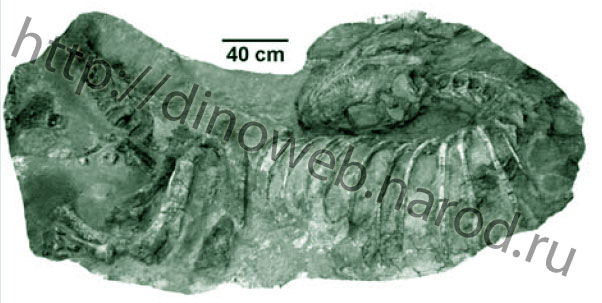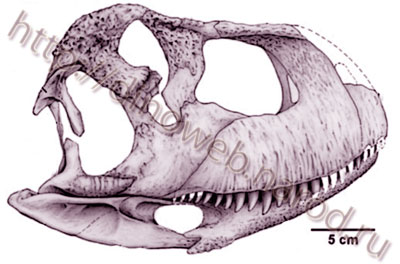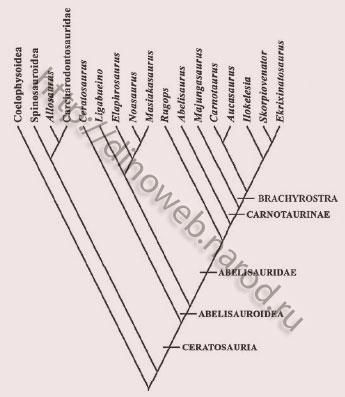
Complete Data Base of Paleozoic and Mesozoic Tetrapods.
Paleo-News and illustrations. Big electronic PDF-library.
| |
| PaleoNews |
| Classification |
| Books and Articles |
| Contact |
| Forum |
сайт о динозаврах
рейтинг сайтов
Free Counter
myspace hit counter
Skorpiovenator |
Genus: Skorpiovenator Canale, J. I., Scanferla, C. A., Agnolin, F. L., and Novas, F. E., 2009 Classification: Dinosauria - Saurischia - Theropoda - Ceratosauria - Abelisauroidea - Abelisauridae - Carnotaurinae Etymology: The generic name derives from the Latin words skorpios (scorpion) and venator (hunter) because of the abundance of living scorpions moving around the excavation. Synonyms: none Type species: S. bustingorryi Canale, J. I., Scanferla, C. A., Agnolin, F. L., and Novas, F. E., 2009 Other Species: none Diagnosis: as for type species Species: Skorpiovenator bustingorryi Canale, J. I., Scanferla, C. A., Agnolin, F. L., and Novas, F. E., 2009 Etymology: The specific name honours the late Manuel Bustingorry, owner of the farm where the specimen was excavated. Synonyms: none Holotype: MMCH-PV 48 (Museo Municipal “Ernesto Bachmann”, Villa El Chocon, Neuquen, Argentina): an articulated skeleton represented by an almost complete skull and mandibles and most of the postcranial bones, lacking the right forearm and the distal half of the tail. Referred Specimens: none Time: Late Ctetaceous (Late Cenomanian–Early Turonian). Horizon: The specimen was found in fluvial sandstones with intercalated mudstones, belonging to the lower levels of the Huincul Formation. This formation has yielded other theropod taxa, including the carcharodontosaurid Mapusaurus roseae and the abelisaurid Ilokelesia aguadagrandensis. Skorpiovenator differs from the latter taxon in the morphology of thepostorbital and quadrate bones. Location: Bustingorry’s farm, 3 km NWof Villa El Chocon, Neuquen Province, NW Patagonia, Argentina. Total length: The preserved length of the skeleton (taken from the premaxilla to the 12th caudal vertebra) is 4.35 m, thereby allowing a total length estimate of 6 m for the complete skeleton. Mass: 500-700 kg. Diagnosis: Skorpiovenator is distinguished from other abelisaurids on the basis of the following unique traits: (1) ascending process of maxilla homogeneously wide rostrocaudally, (2) maxillary horizontal ramus dorsoventrally deep with subparallel dorsal and ventral margins, (3) maxilla/jugal contact subvertical, (4) 19 maxillary teeth, (5) lacrimal rostrally projected and with well-developed suborbital process, (6) quadratojugal with pronounced caudal notch, (7) dentary with caudoventral process bifurcated to receive rostral end of angular, and (8) angular with rostral end dorsoventrally deep to fit between splenial and prearticular Comments: The holotype Skorpiovenator bustingorryi (complete skeleton) was found in Late Cenomanian–Early Turonian outcrops of NW Patagonia, Argentina. This new taxon is deeply nested within a new clade of South American abelisaurids, named Brachyrostra. Within brachyrostrans, the skull shortening and hyperossification of the skull roof appear to be correlated with a progressive enclosure of the orbit, a set of features possibly related to shock-absorbing capabilities. Moreover, the development of horn-like structures and differential cranial thickening appear to be convergently acquired within Abelisauridae. Based on the similarities between Skorpiovenator and carcharodontosaurid tooth morphology, we suggest that isolated teeth originally referred as post-Cenomanian Carcharodontosauridae most probably belong to abelisaurids (Canale, J. I., Scanferla, C. A., Agnolin, F. L., and Novas, F. E., 2009). Illustrations: References: © Tetrapoda Database Roman Ulansky roman.ulansky@gmail.com or adios85@mail.ru
|



